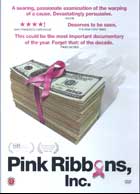
Pink Ribbons, Inc. 2011
Distributed by First Run Features, 630 Ninth Avenue, Suite 1213, New York, NY 10036; 212-243-0600
Produced by National Film Board of Canada
Directed by Lea Pool
DVD , color, 98 min.
Sr. High - General Adult
American Studies, Business, Health Sciences
Date Entered: 06/04/2013
ALA Notable: yes
Reviewed by Michael J. Coffta, Business Librarian, Bloomsburg University of Pennsylvania
“Eye-opening” would be an understatement. This work positively rips the entire seemingly noble Pink Ribbon International to shreds. It begins with a brief history of the movement, designed to raise awareness of breast cancer when the prevalence of breast cancer was little known in the U.S. In the beginning, the movement was inspirational, informative, and, to its credit, it gained the attraction and notoriety it set out to achieve. The film makers stridently argue that that mission has been accomplished, and that a self-perpetuating, counterproductive pink ribbon culture has evolved. The pink ribbon following exists for its own sake and not for the purpose of progressing breast cancer research. Instead, it has become a dumbed-down feel-good exercise in ultimate ineffectiveness.
The film provides a montage of government, corporate, and other entities embracing the public display of the movement’s signature hot pink. Such entities, the filmmakers contend, embrace the cause more for their self-image than for advances for the actual cause of breast cancer research. There are shocking stories in which companies actually spend more on pink ribbon campaign advertising than on actual donations. The NFL sought to clean up its image by espousing the pink ribbon campaign. Several companies support the pink ribbon campaign and simultaneously expose consumers and/or employees to cancer-causing agents. Estee Lauder actually includes carcinogens in products with pink ribbons on them, just as Yoplait sells dairy products containing RBGH (growth hormone). These and other corporations frame the cause in a certain pleasant way, so as not to alienate the audience. Furthermore, only approximately 3% of proceeds actually go to prevention and/or research. Even then, the filmmakers contend that breast cancer research is conducted poorly with minimal communication among researchers and the public.
The filmmakers accuse the pink ribbon cause of willful and complete misdirection, referring to it as the “tyranny of cheerfulness.” The message is far too glossy, and actually alienates breast cancer patients. The film offers tearful accounts of the devastation from the disease, and the genuine outrage of those patients who have received no support from Pink Ribbon International, and feel that the organization is exploiting their illness.
The film concludes with a simple call for people to support cancer research locally, or directly fund actual cancer research institutes. It calls for better communication amongst cancer researchers so that researchers do not repeat others’ failed trials. The work includes a hopeful account of a simple email that successfully changed a company’s production and inclusion of toxins in its product.
Mountainous praise has been heaped upon this film, and deservedly so. Every so often, a life changing documentary is made that unequivocally calls the audience to action. This is clearly such a film. This work is powerful and relentless without being excessively militant.